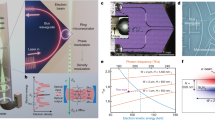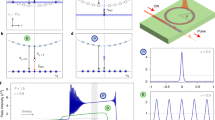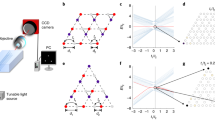Abstract
We introduce a photonic crystal ring cavity that resembles an internal gear and unites photonic crystal (PhC) and whispering gallery mode (WGM) concepts. This ‘microgear’ photonic crystal ring (MPhCR) is created by applying a periodic modulation to the inside boundary of a microring resonator to open a large bandgap, as in a PhC cavity, while maintaining the ring’s circularly symmetric outside boundary and high optical quality factor (Q), as in a WGM cavity. The MPhCR targets a specific WGM to open a large PhC bandgap up to tens of free spectral ranges, compressing the mode spectrum while maintaining the high-Q, angular momenta and waveguide coupling properties of the WGM modes. In particular, near the dielectric band edge, we observe modes whose group velocity is slowed down by 10 times relative to conventional microring modes while supporting Q = (1.1 ± 0.1) × 106. This Q is around 50 times that of the previous record in slow-light devices. Using the slow-light design as a starting point, we further demonstrate the ability to localize WGMs into photonic crystal defect modes, enabling a more than 10 times reduction of mode volume compared with conventional WGMs while maintaining a high Q value of up to (5.6 ± 0.1) × 105. Importantly, this additional photonic crystal defect localization is achievable without requiring detailed electromagnetic design. Moreover, controlling their resonance frequencies and waveguide coupling is straightforward in the MPhCR, owing to its WGM heritage. In using a PhC to strongly modify the fundamental properties of WGMs, such as group velocity and localization, the MPhCR provides an exciting platform for a broad range of photonics applications, including sensing/metrology, nonlinear optics and cavity quantum electrodynamics.
This is a preview of subscription content, access via your institution
Access options
Access Nature and 54 other Nature Portfolio journals
Get Nature+, our best-value online-access subscription
$29.99 / 30 days
cancel any time
Subscribe to this journal
Receive 12 print issues and online access
$209.00 per year
only $17.42 per issue
Buy this article
- Purchase on Springer Link
- Instant access to full article PDF
Prices may be subject to local taxes which are calculated during checkout



Similar content being viewed by others
Data availability
The data that support the plots within this paper and other findings of this study are available from the corresponding authors upon reasonable request.
References
Vahala, K. J. Optical microcavities. Nature 424, 839–846 (2003).
O’Brien, J. L., Furusawa, A. & Vučković, J. Photonic quantum technologies. Nat. Photon. 3, 687–695 (2009).
Strekalov, D. V., Marquardt, C., Matsko, A. B., Schwefel, H. G. L. & Leuchs, G. Nonlinear and quantum optics with whispering gallery resonators. J. Opt. 18, 123002 (2016).
Aspelmeyer, M., Kippenberg, T. J. & Marquardt, F. Cavity optomechanics. Rev. Mod. Phys. 86, 1391–1452 (2014).
Vollmer, F. & Yang, L. Label-free detection with high-Q microcavities: a review of biosensing mechanisms for integrated devices. Nanophotonics 1, 267–291 (2012).
Matsko, A. B. & Ilchenko, V. S. Optical resonators with whispering gallery modes—part I: basics. IEEE J. Sel. Top. Quantum Electron. 12, 3–14 (2006).
Istrate, E. & Sargent, E. H. Photonic crystal heterostructures and interfaces. Rev. Mod. Phys. 78, 455–481 (2006).
Lu, X. et al. Efficient telecom-to-visible spectral translation using silicon nanophotonics. Nat. Photon. 13, 593–601 (2019).
Smith, C. J. et al. Coupled guide and cavity in a two-dimensional photonic crystal. Appl. Phys. Lett. 78, 1487–1489 (2001).
Kim, S. H. et al. Two-dimensional photonic crystal hexagonal waveguide ring laser. Appl. Phys. Lett. 81, 2499–2501 (2002).
Zhang, Y. et al. High-quality-factor photonic crystal ring resonator. Opt. Lett. 39, 1282–1285 (2014).
Lee, J. Y. & Fauchet, P. M. Slow-light dispersion in periodically patterned silicon microring resonators. Opt. Lett. 37, 58–60 (2012).
Zhang, Y. et al. Slow-light dispersion in one-dimensional photonic crystal racetrack ring resonator. IEEE Photon. Technol. Lett. 27, 1120–1123 (2015).
Gao, G. et al. Air-mode photonic crystal ring resonator on silicon-on-insulator. Sci. Rep. 6, 19999 (2016).
McGarvey-Lechable, K. et al. Slow light in mass-produced, dispersion-engineered photonic crystal ring resonators. Opt. Express 25, 3916–3926 (2017).
Lo, S. M., Lee, J. Y., Weiss, S. M. & Fauchet, P. M. Bloch mode selection in silicon photonic crystal microring resonators. Opt. Lett. 43, 2957–2960 (2018).
Lu, X., Rogers, S., Jiang, W. C. & Lin, Q. Selective engineering of cavity resonance for frequency matching in optical parametric processes. Appl. Phys. Lett. 105, 151104 (2014).
Arbabi, A., Kamali, S. M., Arbabi, E., Griffin, B. G. & Goddard, L. L. Grating integrated single mode microring laser. Opt. Express 23, 5335–5347 (2015).
Yu, S. P. et al. Spontaneous pulse formation in edgeless photonic crystal resonators. Nat. Photon. 15, 461–467 (2021).
Cai, X. et al. Integrated compact optical vortex beam emitters. Science 338, 363–366 (2012).
Feng, L., Wong, Z. J., Ma, R.-M., Wang, Y. & Zhang, X. Single-mode laser by parity-time symmetry breaking. Science 346, 972–975 (2014).
Krauss, T. F. Slow light in photonic crystal waveguides. J. Phys. D 40, 2666–2670 (2007).
Yu, S. P. et al. Nanowire photonic crystal waveguides for single-atom trapping and strong light-matter interactions. Appl. Phys. Lett. 104, 111103 (2014).
Baba, T. Slow light in photonic crystals. Nat. Photon. 2, 465–473 (2008).
Arcari, M. et al. Near-unity coupling efficiency of a quantum emitter to a photonic crystal waveguide. Phys. Rev. Lett. 113, 093603 (2014).
Fujita, M. & Baba, T. Microgear laser. Appl. Phys. Lett. 80, 2051–2053 (2002).
McGarvey-Lechable, K. & Bianucci, P. Maximizing slow-light enhancement in one-dimensional photonic crystal ring resonators. Opt. Express 22, 26032–26041 (2014).
Shi, Z. & Boyd, R. W. Slow-light interferometry: practical limitations to spectroscopic performance. J. Opt. Soc. Am. B 25, C136–C143 (2008).
Shi, Z., Boyd, R. W., Camacho, R. M., Vudyasetu, P. K. & Howell, J. C. Slow-light Fourier transform interferometer. Phys. Rev. Lett. 99, 240801 (2007).
Boyd, R. W. Slow and fast light: fundamentals and applications. J. Mod. Opt. 56, 1908–1915 (2009).
Vučković, J., Lončar, M., Mabuchi, H. & Scherer, A. Design of photonic crystal microcavities for cavity QED. Phys. Rev. E 65, 016608 (2001).
Srinivasan, K. & Painter, O. Momentum space design of high-Q photonic crystal optical cavities. Opt. Express 10, 670–684 (2002).
Englund, D., Fushman, I. & Vučković, J. General recipe for designing photonic crystal cavities. Opt. Express 13, 5961–5975 (2005).
Asano, T., Song, B.-S., Akahane, Y. & Noda, S. Ultrahigh-Q nanocavities in two-dimensional photonic crystal slabs. IEEE J. Sel. Top. Quantum Electron. 12, 1123–1134 (2006).
Quan, Q. & Loncar, M. Deterministic design of wavelength scale, ultra-high Q photonic crystal nanobeam cavities. Opt. Express 19, 18529–18542 (2011).
Li, Q., Davanço, M. & Srinivasan, K. Efficient and low-noise single-photon-level frequency conversion interfaces using silicon nanophotonics. Nat. Photon. 10, 406–414 (2016).
Moille, G. et al. Broadband resonator-waveguide coupling for efficient extraction of octave-spanning microcombs. Opt. Lett. 44, 4737–4740 (2019).
Lu, X. et al. Milliwatt-threshold visible–telecom optical parametric oscillation using silicon nanophotonics. Optica 6, 1535–1541 (2019).
Marty, G., Combrié, S., Raineri, F. & De Rossi, A. Photonic crystal optical parametric oscillator. Nat. Photon. 15, 53–58 (2021).
Lu, X., Rao, A., Moille, G., Westly, D. A. & Srinivasan, K. Universal frequency engineering for microcavity nonlinear optics: multiple selective mode splitting of whispering-gallery resonances. Photon. Res. 8, 1676–1686 (2020).
Douglas, J. S. et al. Quantum many-body models with cold atoms coupled to photonic crystals. Nat. Photon. 9, 326–331 (2015).
Ji, X., Roberts, S., Corato-Zanarella, M. & Lipson, M. Methods to achieve ultra-high quality factor silicon nitride resonators. APL Photon. 6, 071101 (2021).
Lukin, D. M. et al. 4H-silicon-carbide-on-insulator for integrated quantum and nonlinear photonics. Nat. Photon. 14, 330–334 (2020).
Lodahl, P., Mahmoodian, S. & Stobbe, S. Interfacing single photons and single quantum dots with photonic nanostructures. Rev. Mod. Phys. 87, 347–400 (2015).
Johnson, S. G. & Joannopoulos, J. D. Block-iterative frequency-domain methods for Maxwell’s equations in a planewave basis. Opt. Express 8, 173–190 (2001).
Balram, K. C. et al. The nanolithography toolbox. J. Res. Natl Inst. Stand. Technol. 121, 464–475 (2016).
Xu, Y., Li, Y., Lee, R. K. & Yariv, A. Scattering-theory analysis of waveguide-resonator coupling. Phys. Rev. E 62, 30–33 (2000).
Afzal, F. O., Halimi, S. I. & Weiss, S. M. Efficient side-coupling to photonic crystal nanobeam cavities via state-space overlap. J. Opt. Soc. Am. B 36, 585–595 (2019).
Kippenberg, T. J., Spillane, S. M. & Vahala, K. J. Modal coupling in traveling-wave resonators. Opt. Lett. 27, 1669–1671 (2002).
Hughes, S., Ramunno, L., Young, J. F. & Sipe, J. E. Extrinsic optical scattering loss in photonic crystal waveguides: role of fabrication disorder and photon group velocity. Phys. Rev. Lett. 94, 033903 (2005).
Acknowledgements
This work is supported by the DARPA SAVaNT and NIST-on-a-chip programs. X.L. acknowledges support under the Cooperative Research Agreement between the University of Maryland and NIST-PML, award no. 70NANB10H193. We thank Z. Shi and V. Aksyuk for helpful discussions.
Author information
Authors and Affiliations
Contributions
X.L. led the design, fabrication and measurement of the MPhCR devices. A.M. led the simulation with help from X.L., and all authors participated in the analysis and discussion of the results. X.L. and K.S. wrote the manuscript with assistance from A.M., and K.S. supervised the project.
Corresponding authors
Ethics declarations
Competing interests
NIST has filed a provisional patent application, with X.L. and K.S. listed as inventors, related to the work presented in this article.
Additional information
Peer review information Nature Photonics thanks the anonymous reviewers for their contribution to the peer review of this work.
Publisher’s note Springer Nature remains neutral with regard to jurisdictional claims in published maps and institutional affiliations.
Extended data
Extended Data Fig. 1 Simulated band diagrams and mode profiles of MPhCR devices.
a, Simulated photonic bands for the MPhCR devices experimentally studied in Fig. 2e, with A varying from 550 nm (darker blue) to 1150 nm (purple), as well as the control device (grey). The solid black lines correspond to the light cone with n = 1.44, the refractive index of the silica substrate. The slow light modes at the air band-edge (a0) and dielectric band-edge (s0) of the device with A = 550 nm (blue) are highlighted by open circles. b-e, Finite-element method (FEM) simulations of a unit cell for the a0 and s0 modes, displayed from a top view (b,d) over one period of the optical field as well as in a cross-section view (c,e). Both modes have dominant electric fields in the radial (horizontal) direction. The resonance frequencies are 193.9 THz and 191.1 THz, within 1 THz of the experimental data (Fig. 2e,g). These a0 and s0 modes have unit cell mode volumes of V = 0.29(λ/n)3 and V = 0.35(λ/n)3 with confinement factors of η = 71 % and η = 84 %, respectively. The mode volumes for a0 and s0, containing 162 cells, are 47(λ/n)3 and 56(λ/n)3. See Methods for more details on the simulations and definition of mode volume and confinement factor.
Extended Data Fig. 2 Simulated mode profiles and mode volumes for the unit cell and the photonic crystal defect modes build on this cell.
a,b, Top view and cross-section view of s0 FEM-simulated mode profiles in a unit cell with m = 162 and A = 1150 nm. The calculated resonance frequency is 191.0 THz, within 1 THz of the experimental data (Fig. 2e). The mode volume for a unit cell is 0.20 μm3, that is, 0.40(λ/n)3, with η = 86 % confinement factor in Si3N4. The mode volume of s0 over the whole ring is 64(λ/n)3. c, Photonic crystal (PhC) defects can be built based on (a). Such dPhC cavity modes are created by a reduction in A (Δ) by 10 % (magenta) to 30 % (black) at the defect center, and a quadratic grading in A over N cells is shown. The mode volumes can be further optimized by using a larger Δ and an optimized N, or using material stacks with larger refractive index contrasts, for example, silicon on insulator (SOI). d,e, Two examples of the dPhC mode (g) with {N, Δ} = {16, 30 %} and {48, 10 %}, with mode volumes of 3.3(λ/n)3 and 5.5(λ/n)3, respectively.
Extended Data Fig. 3 Supporting data for slow light MPhCR.
a, Characterization of a slow light device with A = 550 nm modulation. This modulation opens up a 29 nm separation between modes in the middle of the spectrum. Comparing this device to the bare microring (Fig. 2c), we see that the air band and dielectric band are symmetrically located, which is atypical to most photonic crystal designs. The dielectric band, for example, shows a singlet resonance at the band-edge (s0), and doublet resonances for all other slow light modes (s1 and s2 shown here). The s0 mode in this device has a SR of 4.29 ± 0.01 (uncertainty propagated from the FSR between s0 and s1±, see Methods for details) and Q0 = (4.4 ± 0.1) × 105 (uncertainty from one-standard deviation in nonlinear fitting). b, Extraction of SR for devices with A from 550 nm (darker blue) to 1150 nm (purple) using free spectral ranges (see Methods). Dashed lines are for guidance in viewing. The red vertical dashed line at Δm = 0.5 is used to estimate the SR of s0 mode, whose values are shown versus A in the inset (red). The SR is closely related to the ‘hyperbolic’ index ζ, the parameter describing the curvature of the dielectric band (blue). See Methods for the equation for ζ. c,Q analysis of the s0 modes of slow light devices for control devices (A = 0 nm) and MPhCR devices with A from 550 nm to 1150 nm. Devices with two waveguide-ring coupling gaps (Gs) are shown with G = 500 nm (blue) and G = 650 nm (red). In general, there seems to exist parasitic loss for MPhCR devices, that is, extra loss (reduced Q0 effectively) induced by coupling, in G = 500 nm cases.
Extended Data Fig. 4 Supporting data on improving Q of the MPhCR.
a, A slow-light device after optimization shows SR = 10 ± 2 for s0 and s1 modes. b, The s0 mode has an intrinsic optical Q of 1.1 million.
Extended Data Fig. 5 Supporting data on frequency control and coupling of dPhC modes in the MPhCR.
a-c, Control of the frequency of the g defect mode by a number of means besides varying the base modulation amplitude A (as in Fig. 3c), including varying m (the targeted azimuthal mode number), N (the number of periods comprising the potential), and Δ (the modulation depth of the potential), from left to right, respectively. Nominal parameters are {m, N, Δ} = {162, 48, 10 %}. The MPhCR has a unique tuning mechanism, in which the modulation period is varied to target different azimuthal mode numbers, for example, m = 162 (blue) and m = 164 (purple) in (a), while the characteristics of the defect (Δ,G,and N) are unchanged. This changes the location of the band-edge, but not the curvature of the dielectric band and the relative frequency of the g mode. This characteristic of the g mode is particularly convenient considering the relation of the MPhCR to control microrings (grey). Otherwise, tuning of the g mode frequency by control of N and Δ results in a largely unchanged dielectric band curvature, with its frequency shifted by < 1 THz, while the g mode frequency is tuned by as much as 2 THz. d-e, Coupling of the MPhCR devices and fitting of the g modes for centered and rotated PhC defects. This series of transmission spectra shows the control of Qc from a regime of deep coupling (Qc ≈ 104, Q0 ≈ 105, K ≈ 10) to one that is strongly undercoupled (Qc ≈ 2 × 107, Q0 ≈ 5 × 105, K ≈ 0.025). We note that the g modes have on-resonance transmission values close to 0 when K ≫ 1, unlike conventional coupling of microring traveling wave modes (see Methods).
Rights and permissions
About this article
Cite this article
Lu, X., McClung, A. & Srinivasan, K. High-Q slow light and its localization in a photonic crystal microring. Nat. Photon. 16, 66–71 (2022). https://doi.org/10.1038/s41566-021-00912-w
Received:
Accepted:
Published:
Issue Date:
DOI: https://doi.org/10.1038/s41566-021-00912-w
This article is cited by
-
Synthetic reflection self-injection-locked microcombs
Nature Photonics (2024)
-
Integrated vortex soliton microcombs
Nature Photonics (2024)
-
Versatile photonic molecule switch in multimode microresonators
Light: Science & Applications (2024)
-
Wavelength-accurate nonlinear conversion through wavenumber selectivity in photonic crystal resonators
Nature Photonics (2024)
-
Chiral exceptional point and coherent suppression of backscattering in silicon microring with low loss Mie scatterer
eLight (2023)



